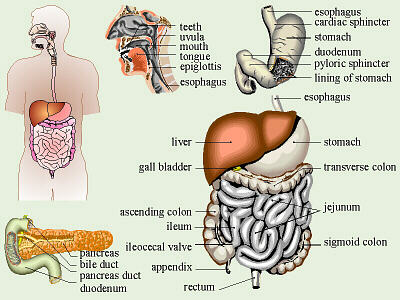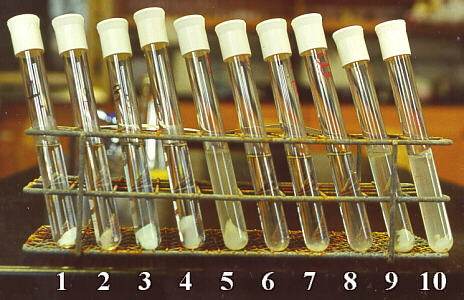Digestive System
2-D says, “We Monarchs are herbivores. More specifically,
since our caterpillars eat leaves, the technical term that describes that is
‘folivore’ (which means leaf-eater) and since we adult butterflies sip nectar,
the technical term
for that is ‘nectarivore’ (which means nectar-eater). We don’t like animals
that are insectivores, because they might eat us, so we evolved a really-good
defense against them. The leaves which our caterpillars eat contain some
toxic chemicals, and the caterpillars just store those in safe places within
their bodies. Even once we reach adulthood, we still have those chemicals
stored in our bodies. All it takes is one taste of one Monarch to convince
a would-be predator to leave us alone. Thus, along with tasting really bad,
we also have evolved our bright orange-and-black color pattern as warning
coloration. We don’t have to hide from predators. We just advertize our
bad taste with our bright colors, and they know not to mess with us.”
Types of Diets:
Most animals have one of three main types of diets: they are
either
carnivores
(carni = flesh; vore = to eat, devour),
herbivores
(herbi = grass),
or
omnivores
(omni = all).
Most humans fall into the last category. In humans, herbivores are usually
called vegetarians. Strict vegetarians who consume no animal products,
whatsoever, are called vegans. Some people are
lacto-ovo-vegetarians, meaning that they also eat dairy products (lacto)
and eggs (ovo).
Here’s an interesting wordstem “trivia”: carni is
also the rootword for carnival. Many people in the Catholic church
traditionally fast during Lent, which begins on Ash Wednesday (40 days plus
Sundays before Easter, so 6 weeks plus 4 days). Thus, the
custom developed of eating up any meat and meat products such as lard left
in the house on the Tuesday before, called “Shrove Tuesday” in English, but
in French, Mardi Gras, which translates as “Fat Tuesday”. For many
people, this developed into a time to get together with family and friends
for one last party (often including consumption of lots of pancakes to use up
any left-over lard) before the somber season of Lent. In some places, such
as New Orleans, this meat-eating party was expanded into a grand celebration
— carnival — one last time to eat meat (and do other things) for a
while. Now, the meaning of that word has evolved, such that if a troupe of
people come to town and set up a Ferris wheel, other rides, games, and booths
for cotton candy and hot dogs, we call that “a carnival.”
Digestion of Food — Mammalian Digestive Tract:
Digestion is the process of breaking down food into
molecules small enough for the body to absorb. Proteins, carbohydrates, and
fat in our diets must be broken down and later, reassembled in forms useful
to our body.

Human Digestive System
(clipart edited from Corel Presentations 8)
The path of food through the human digestive system includes the following
organs and structures:
- the mouth, which includes:
- the teeth, which grind food
to increase the surface area
- the saliva, which includes
mucin, a lubricant; buffers to neutralize acidic foods,
antibacterial agents, and
amylase,
which converts starch to maltose
- the tongue which tastes and
manipulates the food
- the
pharynx,
which in humans, leads to both the trachea and the esophagus.
While food is being swallowed, the
epiglottis
blocks the trachea and the
uvula
blocks off the nose.
- the
esophagus,
which is the tube from the pharynx to the stomach. Food is moved along the
esophagus by
peristalsis,
wave-like contractions of the muscles in the walls of the esophagus. The
lining of the esophagus secretes mucus to lubricate the ball of food.
There are sphincter muscles (rings of constricting muscles) at the top
and bottom of the esophagus.
- the stomach is a J-shaped,
expandable sack, normally on the left side of the upper abdomen. Several
muscle layers surround the stomach, serving to churn food. The stomach can
expand to hold about 2 L of food (= ˝ gal). The stomach contains
hydrochloric acid (HCl) strong enough to dissolve metal (pH about 1.5
to 3, usually around 2), which kills bacteria and helps denature the proteins
in our food, making them more vulnerable to attack by pepsin. The stomach
secretes mucus to protect itself from being digested by its own acid and
enzymes. The stomach also manufactures
pepsin,
an enzyme to digest protein. The average person secretes about 400 mL of
gastric juice
per meal, containing 50 to 300 µg pepsin/mL. For an average of around
200 µg pepsin/mL gastric juice × 400 mL of gastric juice, this would be
80 mg (or 0.080 g) pepsin/meal. For HCl with a concentration of around
6.08 g HCl/L gastric juice × 400 mL of gastric juice, this would be
2.4 g HCl/meal.
Consumption of antacids does just what their name suggests: they drastically
change the pH of the stomach contents, interfering with pepsin’s ability to
digest protein. Here is more background on
pepsin and the effects of antacids.
Here is a photograph of results of an experiment we perform to study pepsin’s
ability to digest the protein in egg white, and a summary of the contents of
each of these test tubes. Notice in the photograph, below, that wherever
the pepsin was present and able to digest the egg white, the egg white is
gone (#6, 7, and 8). The egg white is still present in tubes which did not
contain pepsin (#1, 3, and 4).
Also, the egg white is still present in tubes in which other chemicals that
were present interfered with the pepsin’s ability to do its job by raising
the pH of the solution (# 2, 5, 9, and 10).

Tube
No. |
Distilled
Water |
0.5%
Baking
Soda |
0.8%
Hydrochloric
Acid |
1% Pepsin
Solution |
Other Info/Ingredients
(@ body temp unless noted) |
| 1 |
10 mL |
|
|
|
|
| 2 |
5 mL |
|
|
5 mL |
|
| 3 |
5 mL |
5 mL |
|
|
|
| 4 |
5 mL |
|
5 mL |
|
|
| 5 |
|
5 mL |
|
5 mL |
|
| 6 |
|
|
5 mL |
5 mL |
|
| 7 |
|
|
5 mL |
5 mL* |
*boiled pepsin soln. |
| 8 |
|
|
5 mL |
5 mL |
@ room temp |
| 9 |
|
|
|
5 mL |
§ 5 mL mixture w/ Tums® |
| 10 |
|
|
|
5 mL |
§ 5 mL mixture w/ Rolaids® |
§ For #9 and 10, 100 mL of HCl was mixed with one “dose” of antacid. 5 mL of
that was used.
Conclusion: OTC antacids interfere with pepsin’s ability to digest
protein.
Since proper absorption of dietary calcium and iron depends on an acidic
stomach environment, and people are, thus, counseled to take calcium and/or
iron supplements with orange juice or some other acidic beverage, it would
be reasonable to expect that proper absorption of these minerals would be
inhibited by the same conditions/chemicals which inhibit proper functioning
of pepsin.
- the
cardiac sphincter
(which, officially is not considered to be a true sphincter), which closes
off the top end of the stomach and the pyloric sphincter, which
closes off the bottom
- the small intestine, which
has a length of about 6 m. The surface of the small intestine is wrinkled
and convoluted to produce a greater surface area for absorption. The total
surface area is about 600 m2 (about the size of baseball diamond).
Most enzymatic digestion occurs here. The secretions of the small intestine
include amylase maltase, sucrase, lactase, etc. to digest carbohydrates and
lipase to digest fats. Several other associated organs secrete chemicals
into the small intestine to aid in digestion: the pancreas secretes
enzymes like trypsin, chymotrypsin, and alkali solutions like bicarbonate
as buffers and the liver and gall bladder make and secrete
bile. Bile contains no enzymes, but salts to emulsify fat so it can
be digested.
the sections of the small intestine include:
- the valve between the small and large
intestines, which is the ileocecal valve, a sphincter that separates
the two
- the large intestine or colon,
which begins with a blind pouch called the
cecum.
In humans, this terminates in the appendix, a finger-like extension which may
function in the immune system. The large intestine functions to re-absorb
(resorb) water and in the further absorption of nutrients. The bacterial
flora of the large intestine includes such things as Escherichia coli,
Acidophilus spp., and other bacteria, as well as Candida yeast
(a fungus). These bacteria produce methane (CH4), hydrogen
sulfide (H2S), and other gases as they ferment their food.
Occasionally, some of this gas is released as flatus. As these
bacteria digest/ferment left-over food, they secrete beneficial chemicals
such as vitamin K, biotin (a B vitamin), and some amino acids, and are our
main source of some of these nutrients.
- the rectum is the terminal
portion of the large intestine and functions for storage of the feces,
the wastes of the digestive tract, until these are eliminated. The external
opening at the end of the rectum is called the anus. The anus has two
sphincters, one voluntary and one involuntary. The pressure of the feces on
the involuntary sphincter causes the urge to defecate and the voluntary
sphincter controls whether a person defecates or not.
Some Digestive System Conditions and Terminology:
Belching is when swallowed gas moves up the esophagus
and is released from the mouth and/or nose. Some people, whose larynx had
to be removed, have learned to purposely swallow air and control its release
to enable them to talk.
Vomiting is an important reflex to protect from harmful
substances. Illnesses like flu, extreme pain (anywhere in the body:
migraine, kidney stones. . .), and other stressful conditions can trigger the
emptying of the stomach contents.
Hiatal hernia is caused in part by failure of the
cardiac sphincter to close properly allowing stomach acid to enter and burn
the esophagus.
An ulcer is when the gastric secretions eat through the
stomach (gastric ulcer) or intestinal wall (duodenal ulcer).
Diarrhea
is having very loose, watery feces (due to a number of possible causes) and
constipation is having larger, harder, nearly dry feces. Getting
enough fiber is importance to proper intestinal functioning because it holds
water in the feces. If feces are too dry and hard, they will pass through
the digestive tract with difficulty, possibly leading to diverticulosis or
diverticulitis. Also, due to the increased transit time, there is more time
for bacteria to ferment the left-overs and secrete increased amounts of
carcinogenic byproducts, thereby increasing the person’s chances of colon
cancer.
Copyright © 1996 by J. Stein Carter. All rights reserved.
This page has been accessed  times since 14 Mar 2001.
times since 14 Mar 2001.


